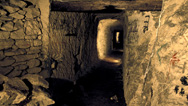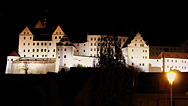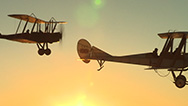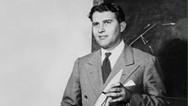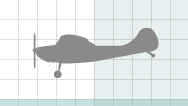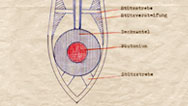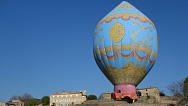
Zeppelin Terror Attack
Discover how the first civilian bombing unfolded as Germany's Zeppelins rained fiery terror on London in World War I. Airing August 30, 2017 at 9 pm on PBS Aired August 30, 2017 on PBS
- Originally aired 01.15.14
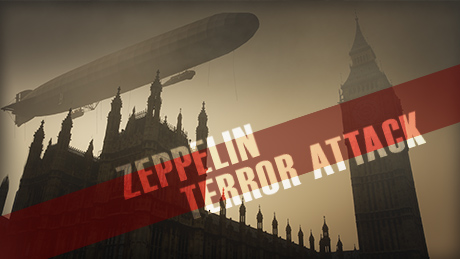
Program Description
Transcript
Zeppelin Terror Attack
PBS Airdate: January 15, 2014
NARRATOR: Eighteen months into World War I, the Germans devastate British cities with enormous airship bombers, called "zeppelins." It's an entirely new kind of terror campaign.
MAN IN GREY SHIRT: There was a policeman running down the road shouting, "They're here, they're here. The Germans are here."
NARRATOR: In a game-changing strategy, the Germans ruthlessly bomb ordinary civilians, from the air.
PROFESSOR ERIC GROVE (Military Historian): This is the beginning…
MAN IN GREY SHIRT: Very much so, yeah.
ERIC GROVE: …of modern warfare, "red in tooth and claw."
NARRATOR: But exactly how these mighty machines worked has been lost to history. Now, engineer Hugh Hunt will investigate the incredible technology behind these gas-filled monsters.
DR. HUGH HUNT (Cambridge University Engineer): Whoa!
NARRATOR: It's an explosive tale of bombs and bullets, with a mystery at its core.
HUGH HUNT: …a big bag full of hydrogen. Why couldn't we shoot them down? They were just there, surely…boom.
NARRATOR: Hugh will discover an unexpected personal connection to the events.
TONY EDWARDS (Ammunition Collector): What we have here is the bullet your uncle designed.
NARRATOR: And he will unravel an amazing story of ingenuity and courage.
HUGH HUNT: Good on you, Uncle Jim.
NARRATOR: Zeppelin Terror Attack, right now, on NOVA.
As the city of London sleeps, German commanders 500 miles away are planning a deadly attack. It's 1915, and World War I battles are raging in the trenches of northern Europe. But at 11p.m., May 31st, the Germans open a new battlefront. They strike at the enemy in their own backyard. For the first time in history, London is under attack from the air.
But these bombs aren't being dropped from planes. The Germans have deployed a terrifying new weapon of mass destruction: the zeppelin. For the next two and a half years, these mighty airships rain down death on British streets, claiming the lives of hundreds of innocent civilians.
They're the biggest flying vessels ever built, able to travel higher and further than any airplanes of the day. How did the Germans construct these colossal machines? What was the secret of their lethal success? And why were they so difficult to destroy?
Friedrichshafen, Germany: the Zeppelin NT airship is the last word in sleek aeronautical engineering. It is the latest in a long line of airships, going back 100 years, that have carried passengers on scenic pleasure cruises.
Taking his seat in the gondola is Cambridge University engineer, Dr. Hugh Hunt. But today, he is taking a trip into the past, to discover how the Germans built the zeppelin bombers of World War I and how the British strove to bring them down.
HUGH HUNT: Just like that?
We've just taken off, and I'm just amazed at how quick that was.
NARRATOR: Hugh was expecting the airship to be slow and cumbersome, but this one is full of surprises.
HUGH HUNT: Are zeppelins are noted at all for maneuverability, or is it that generally airships are maneuverable?
AIRSHIP PILOT: Definitely, the new zeppelin is definitely very maneuverable and far more maneuverable than a lot of the others because…
HUGH HUNT: Whoa.
AIRSHIP PILOT: Yes; as you can see.
HUGH HUNT: Whoa.
AIRSHIP PILOT: See, it's turned very rapidly.
HUGH HUNT: That is remarkable.
NARRATOR: This machine can reach a top speed of 78 miles per hour and stay in the air for 24 hours. And its predecessors of a century ago were almost as fast, just as far-ranging and over twice as big.
On July 2, 1900, three years before the first airplane flew, a retired German soldier called Count Ferdinand von Zeppelin unveiled his own revolutionary flying machine.
He produced a fleet of these airships and fitted them out like luxury liners. They carried well-heeled passengers on grand excursions over the Alps. To an enthusiastic German public, zeppelins were shining beacons of the superiority of their nation's engineering. But with Germany on the brink of war with Britain, the military had other plans for the airships. They would make perfect long-range bombers to strike at the enemy in their own backyard. Bombing London would cause panic in the civilian population and force the British government to pull out of the war.
The brains behind the zeppelin bombing campaign was navy commander Peter Strasser. A confirmed bachelor, married only to his job, he was an inspirational leader who didn't mince his words.
PETER STRASSER (Dramatization/Translated from German): Your sacred obligation: the demolishment of London. Be prepared to make the supreme sacrifice for your Fatherland; crowning glory for any loyal son of Germany.
NARRATOR: In a corner of Commander Strasser's war room, Hugh has assembled a zeppelin think tank. Among the experts is military historian Professor Eric Grove.
ERIC GROVE (Military Historian): Strasser was one of that group of officers of the armed forces who actually came into airships and caught the bug. He suddenly became a convert. It was road-to-Damascus conversion, and this new technology was going to win the war.
NARRATOR: War had broken out on August 4, 1914. The forces of Austria and Germany lined up against those of Russia, France and Britain. Initially, World War I looked like it might be over by Christmas, but it degenerated into a long, bloody war of attrition that would claim the lives of over 16-million people.
Strasser believed he could bring a swift end to the carnage on the battlefield by bombing civilian targets, like London, into submission. The weapon that would deliver victory was the new zeppelin bomber.
ERIC GROVE: The zeppelin raids demonstrated what 20th century war was going to be all about, where the war is carried into the heart of the enemy territory, and you rationalize it by saying the more frightful you are, the sooner the war will end, the sooner the enemy will give in.
NARRATOR: The technology Strasser pinned his faith on employed the latest lightweight materials. Unlike a blimp, which relies on the pressure of the gas inside to keep its shape, the zeppelin had a rigid aluminum alloy skeleton.
This strong lattice structure meant the engineers could make Strasser's new airship enormous. At 650 feet, it was more than twice as long as a jumbo jet. Beneath its canvas skin, it contained 19 bags filled with hydrogen gas.
Hydrogen is lighter than air and provided lift to the airship, but molecules of hydrogen are so small that they pass easily through the weave of most fabrics. Stopping the gas from leaking was one of the major challenges facing the zeppelin engineers. Leaking hydrogen gas was blamed for the notorious Hindenburg disaster of 1937, when the highly flammable gas caught fire and destroyed the giant airship at Lakehurst, New Jersey. Of the 97 people on board, 35 perished.
HUGH HUNT: So this is eight tons, which I can…
Cor, I'm lifting an airship.
NARRATOR: Today, it's non-flammable helium, rather than hydrogen, that makes the modern zeppelin lighter than air.
MAN IN BLACK JACKET: Ah, no, that's crazy. It's the first time I've ever seen anybody do this.
NARRATOR: The helium is held in an envelope made of laminated plastic, but stopping the gas from leaking is still a problem.
MAN IN BLACK JACKET: Gas will escape. We average somewhere from 10 to 15 cubic meters a day of natural loss.
HUGH HUNT: Is it through sort of pinprick holes in the…or is it just through the fabric, or…where is it leaking from?
MAN IN BLACK JACKET: Most of it, most of the helium, it could be pinprick holes that occur over a period of time—very, very difficult to completely seal it. You've got a good seal when there's not so much pressure. When there's pressure and it's stretching, you've got a little bit of a leak.
HUGH HUNT: But here we are in, sort of, 2012, and we've got pretty fancy materials, and the bloody thing still leaks. What about in the early days?
NARRATOR: To make the leak-proof bags that held the hydrogen, the airship pioneers needed a material that was light and strong and in plentiful supply.
They found it in an unlikely place: inside a cow.
HUGH HUNT: One of the things that I found so fascinating is the story of what these bags are made of. And they were made of this stuff, which, well, you look at this and you kind of think, "Well, is it paper? What is it?" It's the intestinal lining of a cow.
MAN IN GREY SHIRT: That's extraordinary, isn't it? I've never actually seen this…
ERIC GROVE: I haven't either.
MAN IN GREY SHIRT: …before.
ERIC GROVE: [inaudible] I've only read about it.
HUGH HUNT: And it's…
ERIC GROVE: Yes, it's very tough.
HUGH HUNT: …it's tough.
NARRATOR: At this processing plant in Middlesbrough, England, animal intestines arrive by the barrel-load from the slaughterhouse. Incredibly, this stuff was the raw material for zeppelins.
Hugh investigates, reluctantly.
HUGH HUNT: I'm not sure I should have had a cooked breakfast this morning.
NARRATOR: These intestines are used to make sausage skins, just as they were in Germany during the First World War. Today, the guts are processed on an industrial scale, as factory owner John Weschenfelder explains.
JOHN WESCHENFELDER (W. Weschenfelder & Sons Sausage Making Supplies): This machine's taking grass out. It's taking the sheets…
HUGH HUNT: It's taking what out?
JOHN WESCHENFELDER: Grass.
HUGH HUNT: Oh, grass.
JOHN WESCHENFELDER: [EXPETIVE DELETED] …go through a second machine.
HUGH HUNT: Yeah?
JOHN WESCHENFELDER: The second machine's taking mucus out.
HUGH HUNT: All right.
JOHN WESCHENFELDER: The final machine is what we call the finishing machine.
NARRATOR: Hugh wants to find out how narrow tubes can be turned into enormous balloons.
HUGH HUNT: And that is what we make balloons out of?
NARRATOR: Sensibly, the zeppelin builders started with the biggest piece of cow gut they could find.
JOHN WESCHENFELDER: This is the appendix. Cows…
HUGH HUNT: Right, I see.
JOHN WESCHENFELDER: It's called the "blind end" of the stomach.
HUGH HUNT: So, that's a cow's appendix.
NARRATOR: The thin membrane that lines the cow's appendix is made of collagen, the same stuff that forms skin and bones. It has some very special properties.
JOHN WESCHENFELDER: See its texture?
HUGH HUNT: Look at that!
JOHN WESCHENFELDER: It's like a balloon.
HUGH HUNT: It's very strong.
JOHN WESCHENFELDER: If we get some warm water and just dip it in the warm water now…
NARRATOR: Somehow, the German zeppelin builders stumbled across the technique for joining the membranes together using nothing more than water.
HUGH HUNT: Like this?
JOHN WESCHENFELDER: Yeah. If we get it over the edges, it'll actually hold on the edges.
HUGH HUNT: Right.
JOHN WESCHENFELDER: If I get another one and just overlap it…
NARRATOR: Using this magical process, the Germans were able to piece together their gigantic gasbags from small strips of cow gut.
JOHN WESCHENFELDER: What we need to do now is leave that to dry.
So we did one, and after two hours, this is what we found.
You can see this, that where it's joined there, it's just melted, blended together, and it's absolutely perfect.
HUGH HUNT: That won't come apart?
JOHN WESCHENFELDER: Just the moisture has bonded it together.
HUGH HUNT: But I want to understand why.
NARRATOR: To find out, Hugh takes the sample back to Cambridge University and asks his colleague, collagen expert Michelle Oyen.
They take a close look at the overlapping joint under a scanning electron microscope.
DR. MICHELLE OYEN (Collagen Expert): Oh, wow.
HUGH HUNT: Golly.
MICHELLE OYEN: We've got all of these tiny, tiny, tiny little fibrils going across the interface here, all the fibers.
HUGH HUNT: All the fibers.
But if this is the interface, what's extraordinary is just how much inter-tangling and intertwining has happened. This doesn't look like just two sheets of anything. It looks like something really quite…
MICHELLE OYEN: Structurally complicated.
HUGH HUNT: …structurally complicated.
NARRATOR: The entwined fibers bind the two sheets of collagen together.
When the collagen is wet, the fibers at the interface slide across one another without sticking, but as they dry out, they become tacky and adhere to one another.
MICHELLE OYEN: Our ancestors were very crafty in the fact that they figured out how to use this natural polymer for other uses. Doesn't surprise me at all.
NARRATOR: Cow gut was a zeppelin's secret weapon, but it took the intestines of more than a quarter of a million animals to make just one airship. The material was so precious to the war effort that, for a time, sausage-making in Germany was verboten.
By January, 1915, the Germans had assembled a fleet of 13 zeppelin bombers. At last, Commander Strasser had the firepower to launch his terror campaign.
He chose targets within easy reach of Germany. One was the seaside resort of Great Yarmouth, in Norfolk. Here is where German bombs first fell on Britain, and this street is where the first civilians died.
The next morning, sleepy towns along the coast awoke to find the war on their doorstep and bodies among the rubble. For the Germans, this was just the start.
ERIC GROVE: Strasser couldn't resist tweaking the lion's tail, as well as by bombarding coastal towns, also bombarding British cities. And he thought that they could inflict so much damage that British morale would crack.
NARRATOR: The city Strasser prized above all others was London.
For the next four months, the Germans launched raid after raid, feeling their way towards the capital. Then, finally, on May 31, 1915, a lone zeppelin made it.
Zeppelin LZ38 bombed the suburbs of north London before heading south, leaving a trail of destruction. In 20 minutes, it had dropped 28 bombs and a further 91 incendiary bombs that were designed to set London ablaze.
MAN IN GREY SHIRT: Their shot was incredible. There are huge burning fires in the streets, explosions going off. People are throwing up their windows to look out and see what's going on, and one man reported that there was a policeman running down the road shouting, "They're here, they're here. The Germans are here."
NARRATOR: Two firebombs fell on a house in Hackney.
MAN IN GREY SHIRT: This couple, Mr. and Mrs. Good, were in their bedroom, and they couldn't get out. And they found Mr. and Mrs. Good you know, burnt, but kneeling by the side of the bed, and the husband had his arm around his wife. And it was almost like they were praying.
NARRATOR: The effectiveness of these German incendiary bombs was brutally obvious. One bomb, identical to those that devastated London that night, has survived intact.
JOHN STARLING (Army Ammunitions Engineer): We have here an original incendiary bomb. It's a direct descendant of projectiles used in earlier wars, which consisted of burning…
ERIC GROVE: Mmm.
JOHN STARLING: …rags, rope and things like that, were loaded into a cage and fired at the enemy position to set fire to it.
HUGH HUNT: Didn't the Romans do that sort of stuff?
JOHN STARLING: Yes, they did, and it hasn't changed. It went right the way through the Napoleonic wars and the Crimean War. And I think this is a direct successor.
NARRATOR: John Starling wants to find out what makes this bomb tick, so he takes it to an army colleague, explosives expert Major Peter Norton.
MAJOR PETER NORTON (Explosives Expert): John's got the bomb here for us.
NARRATOR: They x-ray the bomb to see what's inside.
PETER NORTON: Excellent.
NARRATOR: This allows them to figure out how it worked.
When the bomb hit its target, the impact would have triggered the fuse and set fire to a substance called thermite, a mixture of iron oxide and aluminum that burns with a fierce heat. This, in turn, would cause a tank of benzene, a form of gasoline, to explode.
Peter wants to show John how the firebomb worked.
PETER NORTON: We've certainly never made a World War I zeppelin incendiary before, so it'll be very interesting to see what sort of target effect we get.
NARRATOR: While John and Peter build the bomb, Hugh Hunt prepares the target, a typical 1915 bedroom.
One mystery they hope to solve is why the bomb is bound in rope coated in tar; and another is how the Germans managed to get the tar on, in the first place.
With the tar coating applied, the bomb is ready to be loaded with explosives.
HUGH HUNT: Fill this with thermite, that would make a good bedside lamp.
PETER NORTON: Well, you'd certainly be able to read a book for a short period of time.
We're going to fill this with thermite. Gives off massive amounts of heat, so, as I say, typically, for this, you'd expect to see two- to two-and-a-half -thousand degrees centigrade. I'm going to put some of your benzene in there, as well, and then initiate that electrically.
HUGH HUNT: Perfect.
PETER NORTON: We hope we're going to get a fairly violent conflagration, intense localized heat, which will spread, creating secondary fires.
Three, two, one.
NARRATOR: As Peter predicted, the raging thermite immediately causes the benzene to explode in a fireball, but what's surprising is that the bomb is still burning 15 minutes later, thanks to the tarred rope.
PETER NORTON: We thought the rope would add a burning effect, but it's quite surprising how much time it'll just continue to burn away and use up the fuel that's provided by the tar.
JOHN STARLING: That rope is actually a critical component to the bomb. You want to actually sustain the temperature to set fire to wood, the buildings, et cetera. If you drop enough of them, you'll overload the emergency services, and things like that, so incendiary is actually far worse, in some ways, than high explosives. You see things burning. It's more of a terror weapon.
NARRATOR: The zeppelin commanders were already planning how to take full advantage of their new terror weapon. Some questioned the morality of firebombing civilians, but Strasser was steadfast. He had God on his side.
PETER STRASSER (Dramatization/Translated from German): My men are brave and honorable. Their cause is holy. So how can they sin when they are doing their duty? If what we do is terrible then let terror be Germany's salvation.
NARRATOR: As the war ground to a stalemate on the Western Front, Strasser wanted to ramp up his attacks on the British capital, but just getting an airship there was an almighty challenge. At high altitudes, the crew had to contend with unpredictable weather: heavy rain soaking into the zeppelin's canvas outer skin would weigh the airship down, and high winds could blow it miles off course.
But there was a new problem that hadn't been anticipated. No one had flown so high before, and the crews began to suffer from the debilitating effects of altitude sickness.
Hugh wants the full zeppelin experience, altitude sickness and all, so he visits aeronautics engineer Andy Elson, the first man to pilot a hot air balloon over Everest.
ANDY ELSON (Aeronautical Engineer): The old zeppelins used to fly at 21,000 feet, so, what we want you to do is to experience what they would have suffered. And I won't tell you what the symptoms were. We'll discuss it afterwards.
NARRATOR: Andy will take Hugh up to 21,000 feet, as high as a zeppelin could go, without them having to leave the ground.
By pumping out the air of his sealed chamber, Andy can simulate the thin atmosphere and low pressure of high altitudes. Usually, he tests the performance of airplane engines inside his chamber; today, he's testing Hugh.
MAN IN RED HAT: We're at 12,300 feet.
NARRATOR: To avoid the risk of Hugh passing out during the ascent, he will breathe oxygen until they reach zeppelin altitude.
MAN IN RED HAT: Twenty-one-thousand-six-hundred feet.
ANDY ELSON: …and hit a peak. Stop pumping.
NARRATOR: Now, Hugh will have to quickly adjust to the same thin air as the zeppelin crews and pass a test designed for toddlers.
ANDY ELSON: When you're ready.
NARRATOR: He starts confidently.
HUGH HUNT: It's certainly cold.
ANDY ELSON: Yeah, definitely cold. So: name, address, date of birth and star sign.
NARRATOR: After a few minutes, Hugh struggles to spell the word Capricorn.
HUGH HUNT: I feel as if my eyebrows are falling off. My eyebrows are falling off.
ANDY ELSON: Oh, really?
NARRATOR: Hugh's brain is being starved of oxygen, and it's beginning to show.
HUGH HUNT: I feel as if I'm very heavy.
ANDY ELSON: Be careful.
HUGH HUNT: Whoa. Whoa. That's heavy. So, do I feel heavy because I'm light-headed or…
ANDY ELSON: You haven't got enough oxygen in your muscles to make them work properly.
HUGH HUNT: So it's not because I've lost buoyancy?
ANDY ELSON: No, no.
HUGH HUNT: Wow, that's in…ah.
ANDY ELSON: You should put your mask on.
NARRATOR: A few puffs of oxygen brings Hugh back to normal.
The zeppelin crews realized the restorative effects of oxygen, too, and began carrying cylinders of the gas on high altitude flights. But they hit another problem: seeing where they were going when clouds obscured the ground.
One solution seems remarkable today. They would dangle a tiny capsule, called a sub-cloud car, thousands of feet below the airship, from where a crewman on a telephone would guide them in.
MAN IN GREY SHIRT: The zeppelin would be above the cloud and the sub-cloud car would be below the cloud, and he could say, "Left a bit, right a bit, forward a bit," and release the…
HUGH HUNT: That just sounds…
MAN IN GREY SHIRT: …bombs from there. Horrific, absolutely…
HUGH HUNT: …horrific.
MAN IN GREY SHIRT: …horrific.
NARRATOR: Given the difficulties, it's incredible that any zeppelins made it to London, but on September 8, 1915, Strasser launched a raid, targeting the business and political center of the British capital, and one zeppelin got through.
MAN IN GREY SHIRT: The airship that made most impact that night was that captained by Heinrich Mathy, and, actually, he had been to London before as a tourist, so he actually knew what the landmarks were.
NARRATOR: Mathy followed the chain of tourist sites right up to his primary target: the heart of the Old City. This square mile of real estate was the financial hub of the British Empire.
Mathy's uncanny skills as a navigator would single him out as the most successful airship commander of the war. For his rendezvous with London, he packed a surprise package, weighing some 660 pounds.
MAN IN GREY SHIRT: He is carrying on board the largest single bomb dropped from the air at that time in the war, and he called it his "love gift," his gift of love to London.
NARRATOR: Mathy delivered his gift and much else besides. His firebombs left the textile warehouses around St. Paul's Cathedral burning out of control. His explosive bombs destroyed homes and shops, pubs and buses. In just 10 minutes, 22 civilians, including six children, were killed.
NARRATOR: Newspaper headlines reflected the anger felt by the British public that Germany could indiscriminately target women and children.
Peter Strasser saw things differently.
PETER STRASSER (Dramatization/Translated from German): Strike the enemy where his heart Beats. Slandered as baby killers and murderers of women, do is repugnant but necessary,very necessary. Today there is no such thing as a non-combatant. Modern warfare is total warfare.
ERIC GROVE: As far as Strasser was concerned, he was fighting a total war. Total war had been born. There was no distinction between the front and the rear area. The munitions worker was just as much a target as the people firing the ammunition at the front, and therefore, if it killed children and that had some terror effort and morale effect, well, well and good.
HUGH HUNT: It's the beginning of modern warfare, isn't it?
ERIC GROVE: It's the beginning of modern…
MAN IN GREY SHIRT: Very much so, yeah.
ERIC GROVE: …warfare, "red in tooth and claw."
NARRATOR: By the end of 1915, Londoners had watched German airships rain death down on their city on five occasions, with total impunity. Public outrage at the lack of civil defense forced the British government into action. To take out the zeppelins, they brought in the latest anti-aircraft guns from France and positioned them around the capital.
But the airships flew at night and were virtually impossible to see in the dark. Could they try to hear them coming?
At Spurn Point, on the Yorkshire coast, where the zeppelins crossed the North Sea and entered England, a concrete structure called a sound mirror still stands. It was designed to detect the sound of the approaching airships. The sound mirror worked by amplifying the zeppelins' engine noise. Sound waves hitting the concrete dish would be reflected and focused by the concave surface onto a single spot. This concentration of sound waves would increase the volume.
Using a horn on the end of a pole to pick up the sound, an operator would wait patiently, night after night, with his ears peeled. Once he detected the distinctive drone of zeppelin engines, he would move the horn around until the sound was at its loudest. By tracing back along the line of his pole, he could locate the invisible airship in the night sky.
With the help of acoustics engineer Dr. David Sharp, Hugh hopes to find out how effective this early warning system was.
DR. DAVID SHARP (Cambridge University Engineer): With their stethoscopes on, the listener would listen out, and if they found that the sound was loudest in about this region here, then that would indicate that the aircraft was coming in from the direction that this is pointing, effectively.
HUGH HUNT: Well, why don't we try an experiment?
DAVID SHARP: Yeah, why not?
NARRATOR: Hugh arranges for an aircraft to fly towards the concrete mirror.
They set up two microphones. One picks up the ambient sound at the scene. The other, operated by Hugh, monitors the sound reflected by the mirror, just as the horn did during World War I.
David monitors the output of each mic. Hugh's is in red. If the mirror works, Hugh's mic should pick up the plane first.
DAVID SHARP: So by Hugh moving the microphone around, you can see when the pole's actually pointing towards the sound source, that's when the sound's coming up at its loudest on the microphone.
NARRATOR: Although the plane is too far away to see, it's coming within range of the sound mirror.
HUGH HUNT: I'm hearing it directly behind me. Very clear peaks on the red. I can't hear it without the headphones.
NARRATOR: Hugh finds the area on the dish where the engine noise is loudest. His microphone pole points straight to a spot in the sky.
HUGH HUNT: Well, I reckon it's out there. That's incredible.
DAVID SHARP: That's fantastic.
HUGH HUNT: It's just…
DAVID SHARP: We found that we were able to get an amplification of 20 decibels, maybe four times as loud as you would hear normally, but they were hearing aircraft as far as 15, 20 miles away. Getting that sort of advance warning and you could start to prepare for an imminent air attack.
NARRATOR: The alert would go out to makeshift airfields that had been set up around London. Young pilots were trained in the treacherous art of night flying. As soon as a zeppelin was detected, they would leap into action. To save weight, they flew alone; taking the place of the co-pilot: a Lewis machine gun pointing straight up, so the plane could attack from below.
This is a replica of the B.E.2c aircraft that fought the zeppelins. Pilot Matt Boddington will take Hugh up for a spin.
HUGH HUNT: Did they have seatbelts in those days?
MATT BODDINGTON: They wouldn't have done in those days, no.
NARRATOR: They had no parachutes, either, and had to fly the plane from the back seat.
HUGH HUNT: Whoa, here we go.
NARRATOR: Matt will give Hugh a taste of what it was like to take on a zeppelin in a flimsy contraption made of wood and canvas.
MATT BODDINGTON: But zeppelins, huge great things, size of an ocean liner, and yet this tiny little aircraft…it's like a little flea taking out an elephant.
NARRATOR: But once the pilot located a zeppelin and needed to man the machine gun, the B.E.2c really came into its own.
MATT BODDINGTON: They were actually so stable that, as you can see, I can…quite happy to take my hands off, tap you on the shoulders, and we're fine, and I'm quite happy. This, of course, made it a really good stable gun platform for shooting the zeppelins. Yeah, the plane would almost fly itself.
NARRATOR: But with a zeppelin in his gun sights, the pilot would soon discover the plane's crippling limitation: it lacked firepower. Its puny machine gun bullets would make such tiny holes in the envelope, and the gas would leak out so slowly, that the zeppelin would be able to carry on flying.
MAN IN GREY SHIRT: What the B.E.2c needed now was an armament to enable it to tackle the zeppelins, and that's where a lot of work was going on, behind the scenes, to try and develop a bullet that was going to be effective against zeppelins.
NARRATOR: One scheme was to use a flaming bullet that was meant to set fire to the zeppelin's hydrogen gas, which is highly flammable. The brains behind the idea was a car manufacturer named James Buckingham. In the course of investigating the Buckingham bullet, Hugh discovered he has an unexpected connection to the man.
HUGH HUNT: He's my great-uncle Jim. You know, here was I thinking that I was just going to be exploring zeppelins and finding it out and…
ERIC GROVE: Yes, well, it's amazing.
HUGH HUNT: …but it's turned into a family…
MAN IN GREY SHIRT: Part of the story, yeah.
HUGH HUNT: Ah, just incredible.
NARRATOR: Hugh wants to find out how his great-uncle's incendiary bullets worked. Munitions collector Tony Edwards has some answers.
TONY EDWARDS: What we have here is an original factory drawing of the bullet your uncle designed: Cartridge small arm incendiary Buckingham .303 inch Mark VII B.
HUGH HUNT: 'Cause he had the Buckingham Motor Company or something?
TONY EDWARDS: That's right, the Buckingham Motor Company of Coventry.
HUGH HUNT: Yeah.
TONY EDWARDS: …and he was one of a number of engineers who, when war broke out, turned their creative mind to the problem of shooting down zeppelins and balloons.
HUGH HUNT: But it's a bit of a leap, you know, going from designing and building cars…
TONY EDWARDS: Absolutely, yeah.
HUGH HUNT: …to going to bullets.
TONY EDWARDS: Absolutely, I agree.
HUGH HUNT: You might have thought he would go into making sort of…
TONY EDWARDS: Tanks.
HUGH HUNT: …tanks or engines, aircraft engines or something.
TONY EDWARDS: Yeah, yeah.
HUGH HUNT: But…
TONY EDWARDS: And what you have is this, here, is filled with phosphorus. You know, phosphorus ignites…
HUGH HUNT: Yeah.
TONY EDWARDS: …when it meets the air. And if you look at this bullet here…
HUGH HUNT: That's one of them, is it?
TONY EDWARDS: Yes. You can see, there, the hole that's filled with solder.
NARRATOR: When the Buckingham round is fired, it spins down the barrel and the friction generates heat. This melts the solder that plugs the hole. As the bullet exits the gun, the phosphorus ignites in the air and the spinning motion throws the burning chemical out through the hole.
HUGH HUNT: These bullets, I mean, these presumably don't work anymore, do they?
TONY EDWARDS: Well, we're hoping that they're going to.
HUGH HUNT: This is not a spent bullet?
TONY EDWARDS: No, this is not a spent bullet. This is an unfired,…
HUGH HUNT: Whoa!
TONY EDWARDS: …this is an unfired bullet, still with the solder in, still with the phosphorus in.
HUGH HUNT: So if I pick away at it, with my penknife, at those little holes, that might be…
TONY EDWARDS: I wouldn't advise it.
HUGH HUNT: No, okay, fair enough.
TONY EDWARDS: What we're going to do, we're going to try these out. We're going to fire them and to see if they work.
HUGH HUNT: Oh, god.
NARRATOR: They'll fire the precious 100-year-old Buckingham rounds remotely, just in case they explode in the rifle.
Tony captures the flying bullet using a slow motion camera.
HUGH HUNT: Look at that! And you can see it spinning. Good on you, Uncle Jim.
TONY EDWARDS: As it's being thrown out, it's igniting in the air. When that hits, some of that phosphorus will start burning, which will, of course, ignite the hydrogen.
HUGH HUNT: Well, that's the theory.
TONY EDWARDS: That's the… we shall see.
NARRATOR: But, for all their promise, when the British pilots fired the Buckingham bullets into a zeppelin… nothing. Somehow, they passed straight through the gasbags without the burning phosphorus igniting the hydrogen.
To try and understand why, Hugh revisits aeronautical engineer Andy Elson, who'd watched over Hugh in the low pressure chamber.
HUGH HUNT: I see a cylinder which says "hydrogen" on it.
ANDY ELSON: Yeah. If I just…
NARRATOR: Andy is bubbling hydrogen through a bucket of soapy water to demonstrate to Hugh the flammability of the gas.
ANDY ELSON: We can ignite the bubbles, and they'll burn on your hand without your skin burning.
HUGH HUNT: Unh huh. Okay.
Righty ho, there's hydrogen bubbles.
ANDY ELSON: Yeah.
HUGH HUNT: Okay.
ANDY ELSON: We'll chuck that out of the way.
HUGH HUNT: If I grab hold of that…
Whoa!
ANDY ELSON: That's really dramatic.
HUGH HUNT: Hey, look at that. Well, I knew I needed a shave, but I didn't…
The thing that really gets me about this whole zeppelin thing is that we all know that hydrogen's flammable, and that was really easy to set fire to…
ANDY ELSON: Mmm.
HUGH HUNT: …those bubbles. Then why is it so bloody difficult to set fire to a zeppelin?
NARRATOR: Andy has come up with an experiment to try and solve the mystery.
HUGH HUNT: So, we've got a polythene bag which we're going to fill with hydrogen, and inside is an electric heating element, which is going to glow red hot, just like the burning phosphorus from the incendiary bullet.
NARRATOR: In this experiment, the heating element, red hot at over a thousand degrees Fahrenheit, stands in for the flaming bullet. But, surrounded by only hydrogen inside the bag and no oxygen, it doesn't start a fire.
HUGH HUNT: So that's definitely full of hydrogen.
ANDY ELSON: Mmm.
HUGH HUNT: And I can feel the heat radiating from here.
ANDY ELSON: Mhmm.
HUGH HUNT: That heating element is glowing red hot. If there was oxygen in there, that would have exploded by now.
NARRATOR: Hydrogen, like most things, simply cannot burn in the absence of oxygen. So what will happen if some is allowed into the balloon? Andy will find out by blasting big holes in it to let the air in.
HUGH HUNT: Whoa! Here you go.
This is a difficult process, to try and light this hydrogen. That handful of bubbles? Easy. That was easy because the oxygen is close to the hydrogen and everything's nice and easy. But here, lots of hydrogen, no oxygen in sight, except on the other side of this piece of plastic. Well, nothing was ever going to happen.
You then put holes in.
Whoa! Here we go.
You've got to get the hydrogen and oxygen mixture right, in the right place, and you've got to get your ignition source in the right place.
NARRATOR: Fortunately for the British, engineers were already working on another innovation, an explosive bullet that would rip holes in the gasbag wide enough to allow plenty of oxygen to rush in. This bullet would contain nitroglycerine, an explosive chemical sensitive to shock.
When the bullet hit the canvas skin of the zeppelin, it would slow down, but a steel ball inside would keep moving forward, compressing the nitroglycerine until it exploded, blowing a big hole in the gasbag. The air would rush in, and the oxygen would mix with the hydrogen to create an explosive cocktail of gases.
If the flaming bullet entered the zeppelin at this moment, it would have a good chance of sparking a fire.
The British airmen were told to alternate the bullets when they loaded their machine gun magazines. It would take both rounds to bring down a zeppelin.
JOHN STARLING: They've now got the incendiary and the explosive bullet, and the pilots were instructed to mix their rounds and fire them alternately. And they'd alternate between incendiary and explosive. And the theory was, if you fired enough of them into the aircraft, eventually, They'll he'll start a fire.
NARRATOR: The first opportunity to try out the new ammunition was September 2, 1916, when the Germans launched the biggest raid of the war. A fleet of 16 airships set a course for London. British fighters were scrambled at 11 p.m. The first pilot into the air was 21-year-old William Leefe Robinson.
At 2:15 in the morning, one of the airships was caught in searchlights 12,000 feet above north London. Anti-aircraft guns opened fire.
MAN IN GREY SHIRT: The noise had been so intense that people started coming out of their houses, and up in the sky they see this glowing monster, shells bursting all around it. They describe it as like stars twinkling in the sky, but it's shrapnel shells exploding.
NARRATOR: Leefe Robinson saw the cornered zeppelin, too, and headed towards it. He had the airship at his mercy. He flew along the underside and fired a drum of his special bullets into it. To his dismay, they had no effect.
Undeterred, he reloaded and went back in, but, again, to no effect.
In desperation, and with just one drum of ammo left, he was forced to improvise. He concentrated his fire onto one spot, emptying the whole drum of bullets into the stern. By clustering the rounds into one area, the young pilot managed to open up a big enough hole for the oxygen to rush in, and the alternating bullets finally set the airship alight.
MAN IN GREY SHIRT: When the airship goes up, parents run in and drag their children from their beds. The cheers of the crowd were hard, merciless cheers. This was relief. The people were enjoying this moment.
ERIC GROVE: It's menacing, mmm.
MAN IN GREY SHIRT: We're fighting back.
As it hit the ground, railway engines were blowing their hooters. People started singing the national anthem. People were dancing and singing in the streets. The newspapers the next day described it as the greatest free show London has ever seen.
NARRATOR: On the day that came to be known as "Zep Sunday," tens of thousands of relieved Londoners picked over the wreckage for souvenirs.
Overnight, pilot William Leefe Robinson became the most famous man in Britain. Babies, flowers and hats were named after him and he was mobbed wherever he went.
Within a month, the technique he perfected for taking out airships had brought down two more. It was the beginning of the end for the zeppelin.
Peter Strasser stubbornly refused to accept defeat. On August 5, 1918, with the war effectively lost for Germany, he sent his airships out on one last raid. This time, he would lead the attack himself.
PETER STRASSER (Dramatization/Translated from German): Not that I want to die any more than other men, believe me. Nevertheless, to be up there would mean everything to me.
NARRATOR: Strasser didn't live to see England. A British fighter spotted his zeppelin over the North Sea, and Peter Strasser, himself, fell victim to the deadly alternating bullets.
His master plan, to break an enemy's morale by deliberately targeting civilians, had failed, but the terror it inflicted on the people of Britain would find its full expression in the next war. The great airships would be overtaken by other technology, as engineers would find more efficient ways to deliver death from the sky.
Broadcast Credits
- PRODUCED BY
- Ian Duncan And Johnny Shipley
- WRITTEN AND DIRECTED BY
- Ian Duncan
- EDITED BY
- Paul Shepard
- PRODUCTION MANAGER
- Lizzie Narey
- DIRECTOR OF PHOTOGRAPHY
- Mike Coles
- SOUND RECORDIST
- Keith Rodgerson
- ORIGINAL MUSIC BY
- Alasdair Reid
- NARRATOR
- Jay O. Sanders
- VISUAL EFFECTS
- Fluid Pictures
- 2D GRAPHICS
- Dinnick & Howells
- PRODUCTION DESIGNERS
- Jamie Andrews
Jason Cole - SFX MAKEUP
- Hannah Wing
- PRODUCTION COORDINATOR
- Rebecca Coleman
- ASSISTANT PRODUCER
- Catherine Watling
- ASSOCIATE RESEARCHER
- Shraddha Chakradhar
- ONLINE EDITOR
- Marc Corrance
- COLORIST
- Vicki Matich
- AUDIO MIX
- Matt Skilton
- PRODUCTION ADMINISTRATION
- Susan Harvard
- HEAD OF PRODUCTION
- Birte Pedersen
- ARCHIVAL MATERIAL
- Critical Past
English Heritage
Footage Farm
Images of War
Imperial War Museum
The National Archives
Raf Museum
Topfoto - SPECIAL THANKS
- Anne Bahnweg, Cambridge University
Dr. June Barrow-Green
Defence Academy of the UK
Dr. Guy Finch
David Kirch
Dr. Michelle Oyen, Cambridge University
Dr. David Sharp, Open University
Martin Taylor
ZLT Zeppelin Luftschifftechnik GmbH & Co KG - NOVA SERIES GRAPHICS
- yU + co.
- NOVA THEME MUSIC
- Walter Werzowa
John Luker
Musikvergnuegen, Inc. - ADDITIONAL NOVA THEME MUSIC
- Ray Loring
Rob Morsberger - CLOSED CAPTIONING
- The Caption Center
- POST PRODUCTION ONLINE EDITOR
- Michael H. Amundson
- DIRECTOR OF PR
- Jennifer Welsh
- PUBLICITY
- Eileen Campion
Eddie Ward - SENIOR RESEARCHER
- Kate Becker
- NOVA ADMINISTRATOR
- Kristen Sommerhalter
- PRODUCTION COORDINATOR
- Linda Callahan
- PARALEGAL
- Sarah Erlandson
- TALENT RELATIONS
- Scott Kardel, Esq.
Janice Flood - LEGAL COUNSEL
- Susan Rosen
- DIRECTOR OF EDUCATION
- Rachel Connolly
- DIGITAL MANAGING PRODUCER
- Kristine Allington
- SENIOR DIGITAL EDITOR
- Tim De Chant
- DIRECTOR OF NEW MEDIA
- Lauren Aguirre
- DEVELOPMENT ASSOCIATE
- Lisa Leombruni
- UNIT MANAGER
- Ariam McCrary
- POST PRODUCTION ASSISTANT
- Brittany Flynn
- POST PRODUCTION EDITOR
- Rebecca Nieto
- POST PRODUCTION MANAGER
- Nathan Gunner
- COMPLIANCE MANAGER
- Linzy Emery
- BUSINESS MANAGER
- Elizabeth Benjes
- DEVELOPMENT PRODUCER
- David Condon
- PROJECT DIRECTOR
- Pamela Rosenstein
- COORDINATING PRODUCER
- Laurie Cahalane
- SENIOR SCIENCE EDITOR
- Evan Hadingham
- SENIOR PRODUCERS
- Julia Cort
Chris Schmidt - SENIOR SERIES PRODUCER
- Melanie Wallace
- MANAGING DIRECTOR
- Alan Ritsko
- SENIOR EXECUTIVE PRODUCER
- PAULA S. APSELL
Produced by Windfall Films Ltd. for NOVA/WGBH Boston in association with Channel 4 and National Geographic Channels
© 2014 Windfall Films Ltd.
All rights reserved
Additional Material © 2014 WGBH Educational Foundation
This program was produced by WGBH, which is solely responsible for its content.
IMAGE
- (Zeppelin over London)
- © WGBH Educational Foundation
Participants
- Ian Castle
- Airship Historian
- Tony Edwards
- Ammunition Collector
- Andy Elson
- Aeronautical Engineer
- Eric Grove
- Military Historian
- Hugh Hunt
- Engineer
- Major Peter Norton
- Explosives Expert
- Michelle Oyen
- Collagen Expert
- Chris Sandford
- Zeppelin Engineer
- David Sharp
- Acoustics Engineer
- John Starling
- Army Ammunitions Engineer
Preview | 00:30
Full Program | 52:52
Full program available for streaming through
Watch Online
Full program available
Soon

